35.128 Caryocolum alsinella (Zeller, 1868)
Status and Distribution
A local to very local species rarely encountered in any numbers as an adult. At some sites it can be readily located, and is occasionally common, as a larva which suggests its skulking nature as an adult may lead to it being over-looked.
Occurs in sandy, coastal areas and predominantly south of a line from the Humber to Morecambe Bay, including several sites in Wales and a few in the Isles of Scilly and south-east and western Ireland. North of the above line it is a rare species with records from the Isle of Man and the Outer Hebrides (on the machair). Details of records from coastal sites in East Lothian, the Inner Hebrides and the Channel Islands are unknown.
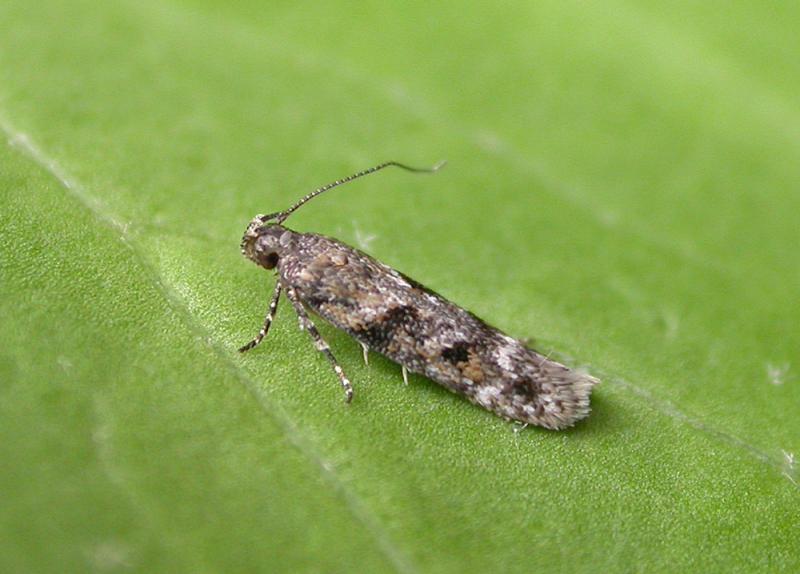
Provisional map
Foodplant and Larval Feeding Signs
Cerastium semidecandrum (little mouse-ear), see plant distribution map, Cerastium diffusum (sea mouse-ear) and also found on Cerastium fontanum (common mouse-ear) where both this and little mouse-ear grow together; Sabulina verna (spring sandwort) in The Burren, Ireland. In Europe also found on Cerastium arvense (field mouse-ear) and Arenaria montana (mountain sandwort).
Initially mines the leaves, later feeding on spun shoots, flowers and seed capsules.
Habitat
Finding the Moth
Larva: reported to feed initially in a leaf mine, thereafter in spinnings on the leaves, flowers and seed-heads. Feeds from late April to mid-June and into late June in the Outer Hebrides.
Adult: occasionally disturbed during the day and is attracted to light.
Similar Species
Caryocolum species generally have a similar wing patterning but vary, even within species, in the extent of darker markings. Where dark forms of any species are encountered it is unlikely that a determination can be made on forewing features alone. Caution should therefore be applied when attempting to identify non-bred specimens and in many cases dissection is recommended - in all but one pair of species (alsinella/viscariella) the genitalia are distinctively different.
Caryocolum alsinella is our smallest Caryocolum although larger specimens overlap to some extent or other with C. viscariella, C. proxima and C. junctella all of which can have fairly similar forewing markings. When fresh specimens are encountered, it may be possible to use the range of features detailed below to name the moth, especially if comparative material is available. However, netted or light-trapped specimens are nearly always likely to require retention of a voucher specimen allowing closer examination and often dissection. A note has also been added below about potential confusion with a dark from of Caryocolum blandulella known to occur in Europe.
Comparison with C. viscariella
C. alsinella (wingspan 7.5 - 11mm) is smaller than C. viscariella (10 - 14mm) but with a slight overlap, has more white scales in the centre of the forewing, lacks the small orange-ochreous patch in the basal area and the angulated fascia from costal to tornal spot is white (light yellowish-brown in C. viscariella). Although the genitalia are very similar the foodplant, distribution and habitat preferences can assist with the identification process.
Comparison with C. proxima
C. alsinella is very similar to C. proxima which differs in the shape of the fuscous blotch and the angle (60-80 degrees) it makes with the costa (c.45 degrees in C. alsinella) and has pinkish scales on the tibia of the forelegs and especially of the midlegs; the latter feature can also be found in C. junctella (see that species for further information). Historically there has been considerable biological and distributional confusion between C. alsinella and C. proxima with many early records of C. proxima (under the name C. maculiferella) referring to C. alsinella.
Comparison with C. junctella
C. junctella can be quite a variable species but has the first discal spot included in the bar from the costa to the fold and the second distal spot not, or only slightly L-shaped. The patches of yellowish scales in the fold and before the white costa are characteristic of C. junctella. The frons (front of the face) is silvery and the head and thorax which are metallic shiny in C. junctella as opposed to shining pale ochreous grey frons and duller head and thorax in C. alsinella. The tarsi of the forelegs and mid-legs in C. junctella often have pinkish scales (although it should be noted they are sometimes whitish and that in Denmark this feature is always lacking), a feature only otherwise seen in C. proxima. C. junctella is the only species of this genus known to hibernate as an adult so date of capture may assist with the identification.
Comparrison with C. blandulella
On the continent there is a dark form of C. blandulella which could cause identification problems if present in the British Isles. C. alsinella has a less distinct costal block and the costal and tornal spot are often separated by orange-brown.
Single brooded from mid-June to late August and rarely into September.
Earliest: 14th June 2007 (VC11).
Latest: several recorded on 14th September 2001 (VC3) are the only September record.

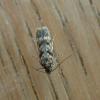
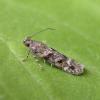
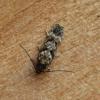
%202_0.jpg)
_0.jpg)
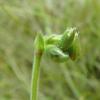
_0.jpg)
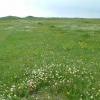
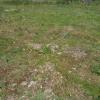
_0.jpg)